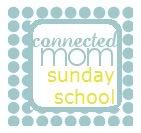 Welcome to the Connected Mom Sunday School. No matter what the course of your child's education, be it unschooling, homeschooling, or conventional schooling, The Connected Mom Sunday School aims to provide you with fun and easy activities for children of all ages and stages. (Have an idea for a Connected Mom Sunday School activity or theme? Either comment below or send your idea to connectedmom (dot) julian (at) gmail (dot) com.)
Welcome to the Connected Mom Sunday School. No matter what the course of your child's education, be it unschooling, homeschooling, or conventional schooling, The Connected Mom Sunday School aims to provide you with fun and easy activities for children of all ages and stages. (Have an idea for a Connected Mom Sunday School activity or theme? Either comment below or send your idea to connectedmom (dot) julian (at) gmail (dot) com.)
I recently learned that September is Children's Good Manners Month. Now, my first reaction to this information was not so positive. I am not a fan of the sort of manners training where children are forced to say "please" or "thank you" or to make insincere apologies. Then I got to thinking about it: gentle parenting is really all about manners! Good manners are about treating people--including little people--with respect. No matter what your parenting style, who doesn't want their children to be considerate of others? This week's activities help to gently encourage good manners.
Toddler
Thank You Coloring Cards
 Toddlers may not have the impulse control to behave like perfect ladies and gentlemen, but it's never too early to teach the important lesson of gratitude. Helping your child make thank you cards is one fun way to teach it. Fisher Price Print & Color Cards offers several different free printable thank you card designs. Just choose a card you like and print it on your own paper. Then give your child some crayons and let her go to town. You might also like to write a message, telling the recipient how your child appreciates their kindness. Your child might not make the connection yet, but making a card draws her attention to the recipient's act of kindness and helps form the habit of sending thank you notes. The site also offers get well cards, perfect for encouraging empathy and compassion.
Toddlers may not have the impulse control to behave like perfect ladies and gentlemen, but it's never too early to teach the important lesson of gratitude. Helping your child make thank you cards is one fun way to teach it. Fisher Price Print & Color Cards offers several different free printable thank you card designs. Just choose a card you like and print it on your own paper. Then give your child some crayons and let her go to town. You might also like to write a message, telling the recipient how your child appreciates their kindness. Your child might not make the connection yet, but making a card draws her attention to the recipient's act of kindness and helps form the habit of sending thank you notes. The site also offers get well cards, perfect for encouraging empathy and compassion.
Preschooler
Reading Emotions
A big part of good manners is paying attention to others' feelings. ChildFun shares a fun idea for helping children read different facial expressions. From magazines, cut pictures that show children and adults displaying a variety of emotions. Glue each picture to a firm backing, such as card stock of poster board and cut it out. Show your child the pictures, one at a time, and ask him how he thinks the person feels. Ask him what he sees in the person's face that led him to that answer. If he is having trouble answering, point out certain facial traits, such as raised eyebrows or a frowning mouth. Older children may also like to make up background stories for why the person feels this way. For example, maybe the little girl is smiling because her brother shared a toy with her.
School-Aged Child
Role Playing
Think of a variety of situations in which good manners are necessary. Some possibilities include: sharing art supplies, standing in line, waiting one's turn to speak, etc. Play out the situation with your child. If possible, involve a sibling or friend in the role play. One example, also taken from ChildFun is the following scenario:
Two children are sitting at a table coloring. One child needs a crayon that is out of his/her reach. It is within the reach of the other child. What should the first child say to the other child nearest the crayons?
See their site for more scenarios. Of course, the best scenarios are those taken from your child's own experience! It's also fun to be silly and use bad manners, then ask your child what you should have done differently.
Older Child (10+)
Formal Night
Perhaps the best way to learn table manners is to practice. Starting out in the comfort of your home helps eliminate uncomfortable situations in a public place. Laura Agadoni of Modern Mom suggests hosting a regular formal night. At dinner time, have everyone in the family dress up. Set the table formally and serve a special meal. As you enjoy your meal, model to your child basic table manners, such as how to hold a fork and where to place your napkin. Rather than criticizing your child's mistakes, point out when you are using manners and describe what you are doing. For example, say: When I sit down to eat, I put my napkin in my lap. Once he has a good grasp on manners, your child could even practice being a gracious host by planning and hosting a dinner party for his friends.



1 comments:
Great blog, full of information/inspiration. Thanks!
www.rebeccabany.com
Post a Comment